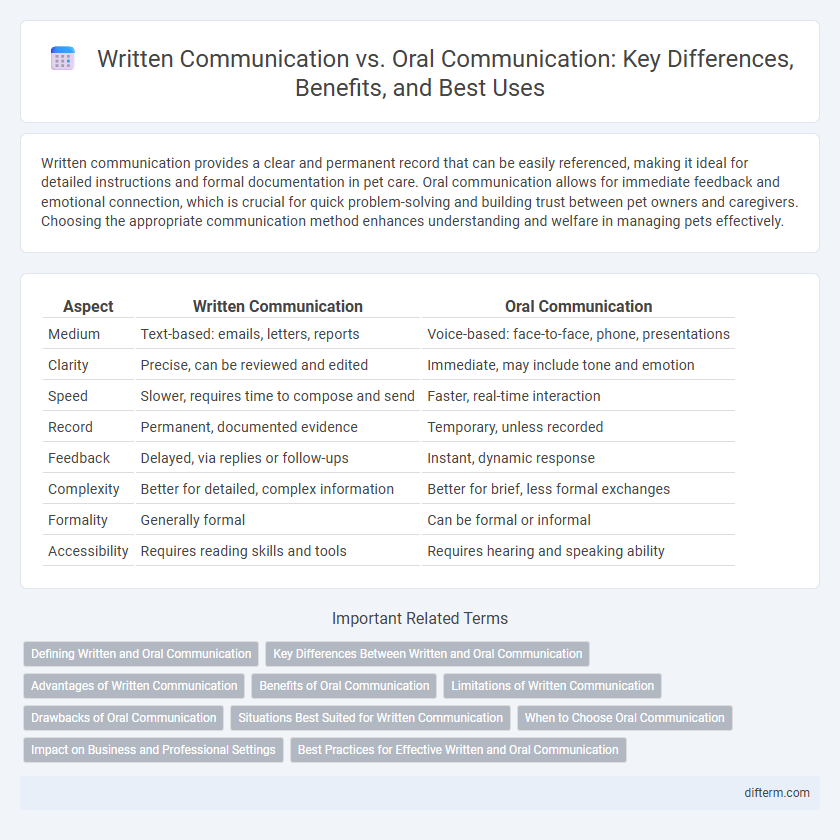Written communication provides a clear and permanent record that can be easily referenced, making it ideal for detailed instructions and formal documentation in pet care. Oral communication allows for immediate feedback and emotional connection, which is crucial for quick problem-solving and building trust between pet owners and caregivers. Choosing the appropriate communication method enhances understanding and welfare in managing pets effectively.
Table of Comparison
| Aspect | Written Communication | Oral Communication |
|---|---|---|
| Medium | Text-based: emails, letters, reports | Voice-based: face-to-face, phone, presentations |
| Clarity | Precise, can be reviewed and edited | Immediate, may include tone and emotion |
| Speed | Slower, requires time to compose and send | Faster, real-time interaction |
| Record | Permanent, documented evidence | Temporary, unless recorded |
| Feedback | Delayed, via replies or follow-ups | Instant, dynamic response |
| Complexity | Better for detailed, complex information | Better for brief, less formal exchanges |
| Formality | Generally formal | Can be formal or informal |
| Accessibility | Requires reading skills and tools | Requires hearing and speaking ability |
Defining Written and Oral Communication
Written communication involves the transmission of messages through text, such as emails, reports, and letters, providing a permanent record and allowing for careful composition and review. Oral communication refers to the exchange of information through spoken words in face-to-face conversations, phone calls, or video meetings, enabling immediate feedback and dynamic interaction. Both forms are essential in professional and personal contexts, each offering unique advantages for clarity, engagement, and documentation.
Key Differences Between Written and Oral Communication
Written communication provides a permanent record and allows for careful editing, making it ideal for complex or detailed information. Oral communication offers immediate feedback and enables real-time interaction, which enhances clarity and emotional expression. The key differences lie in formality, permanence, and the ability to convey tone and intent instantly.
Advantages of Written Communication
Written communication provides a permanent record that enhances accountability and facilitates future reference, ensuring clarity and reducing misunderstandings. It allows for careful crafting and revision, resulting in more precise and thoughtful messaging compared to the spontaneity of oral communication. Additionally, written communication supports distribution to a broad audience simultaneously, improving efficiency in information dissemination.
Benefits of Oral Communication
Oral communication enables immediate feedback through tone, facial expressions, and body language, enhancing message clarity and understanding. It fosters stronger interpersonal relationships by allowing for spontaneous dialogue and emotional connection. Real-time interaction also facilitates quicker decision-making and problem-solving in collaborative environments.
Limitations of Written Communication
Written communication often lacks immediate feedback, causing delays in clarifying misunderstandings and reducing interaction efficiency. It may also fail to convey tone, emotion, and non-verbal cues, leading to misinterpretation of the message. Furthermore, written communication can be time-consuming to produce and requires strong language skills to ensure clarity and effectiveness.
Drawbacks of Oral Communication
Oral communication often faces challenges such as the lack of permanent records, making it difficult to verify or refer back to important information. Misinterpretations can occur due to tone, accent, or speech clarity, leading to misunderstandings. Furthermore, oral communication is limited by geographical and time constraints, reducing its effectiveness in reaching a broader audience simultaneously.
Situations Best Suited for Written Communication
Written communication is best suited for situations requiring detailed records, such as contracts, official correspondence, and formal instructions. It ensures clarity and precision in complex information, allowing recipients to review content at their own pace. Legal matters, policy documentation, and instructional manuals benefit significantly from written communication to maintain accuracy and accountability.
When to Choose Oral Communication
Oral communication is most effective in situations requiring immediate feedback, such as team meetings or negotiations, where tone and body language enhance understanding. It facilitates quick clarification of complex ideas and fosters personal connection, improving trust and collaboration. Choose oral communication when spontaneity, emotional nuance, and real-time interaction are crucial for decision-making and relationship building.
Impact on Business and Professional Settings
Written communication establishes a permanent record essential for legal documentation, policy formulation, and detailed instructions, enhancing clarity and accountability in business and professional settings. Oral communication facilitates immediate feedback, fosters relationship-building, and accelerates decision-making processes, crucial for negotiations and team collaboration. Selecting the appropriate mode depends on the desired impact, with written communication prioritizing precision and formality, while oral communication emphasizes engagement and responsiveness.
Best Practices for Effective Written and Oral Communication
Effective written communication requires clarity, concise language, and proper grammar to ensure the message is easily understood and accessible for future reference. Oral communication benefits from active listening, appropriate tone, and nonverbal cues such as eye contact and gestures to enhance engagement and comprehension. Both methods prioritize audience awareness and feedback to improve message accuracy and foster meaningful interaction.
written communication vs oral communication Infographic

 difterm.com
difterm.com